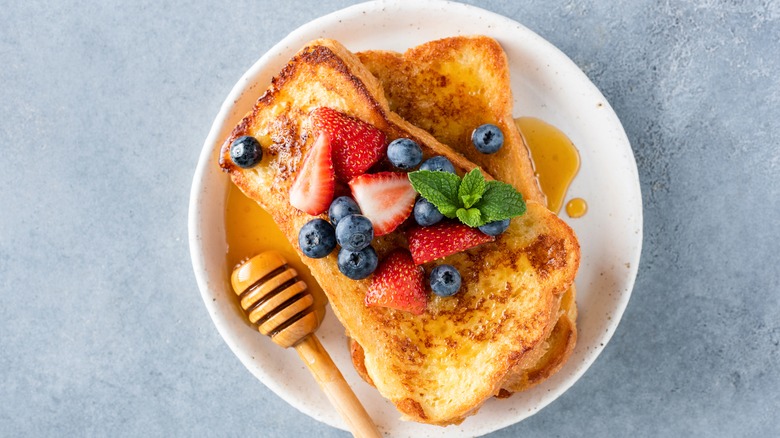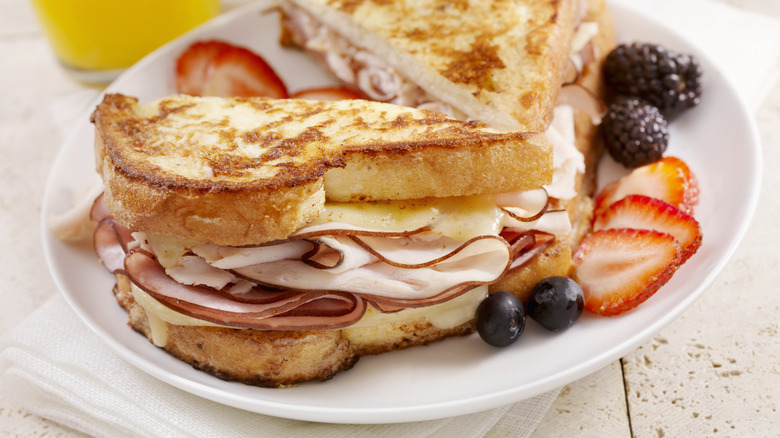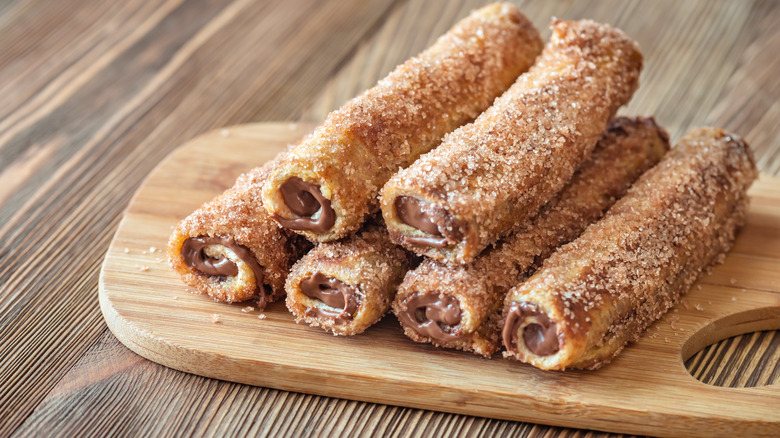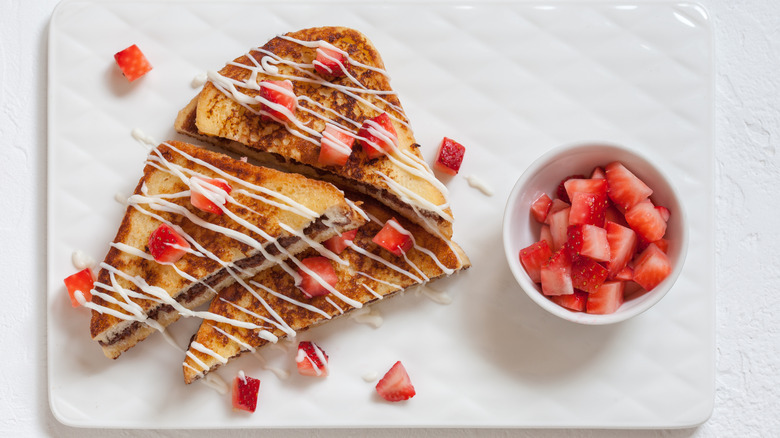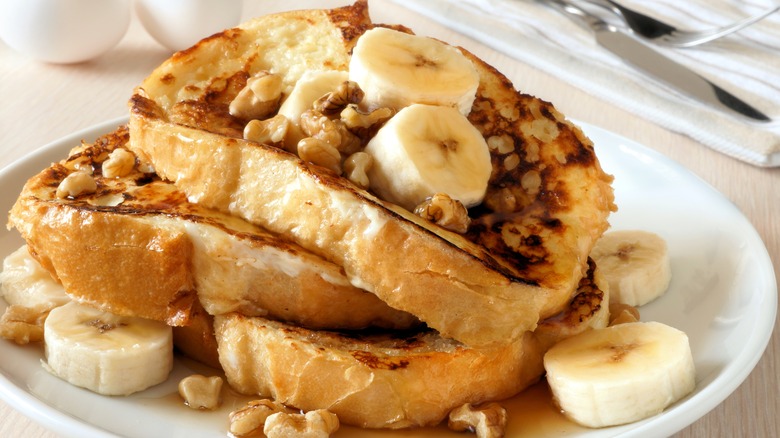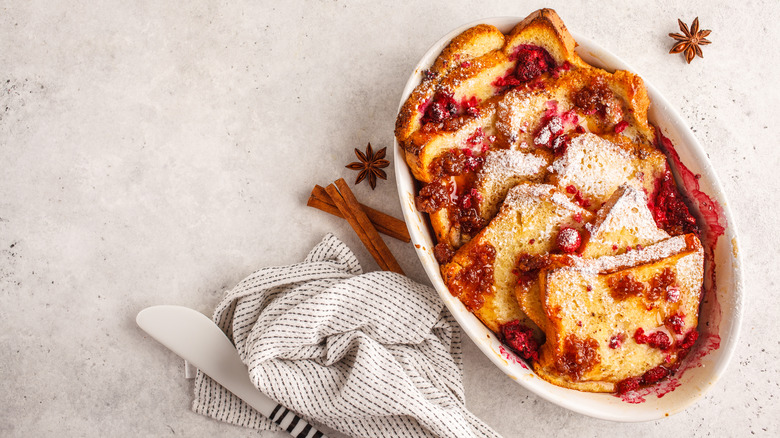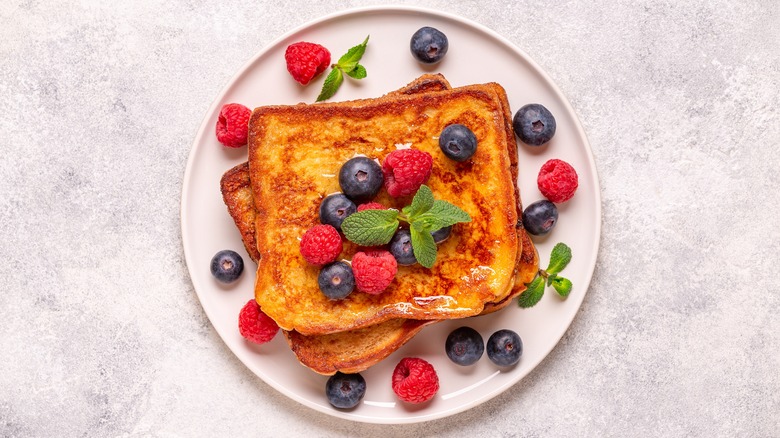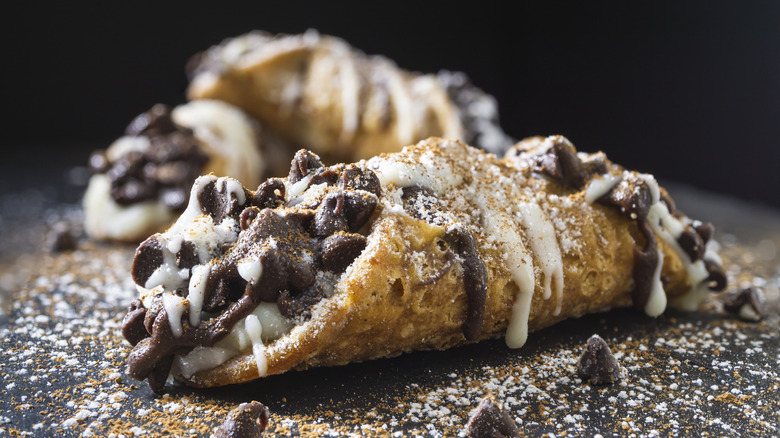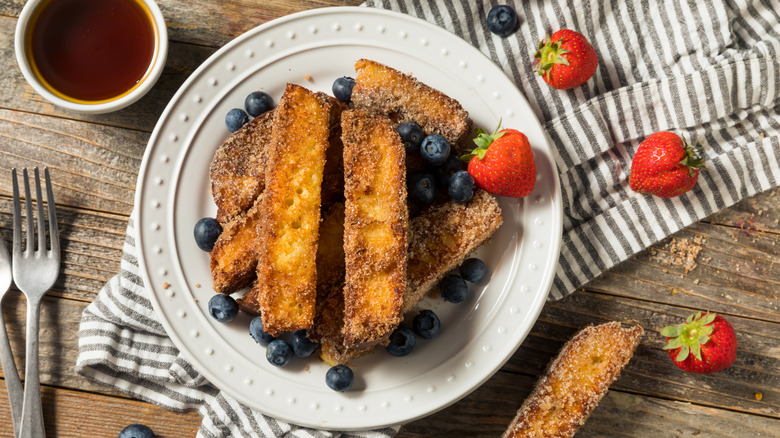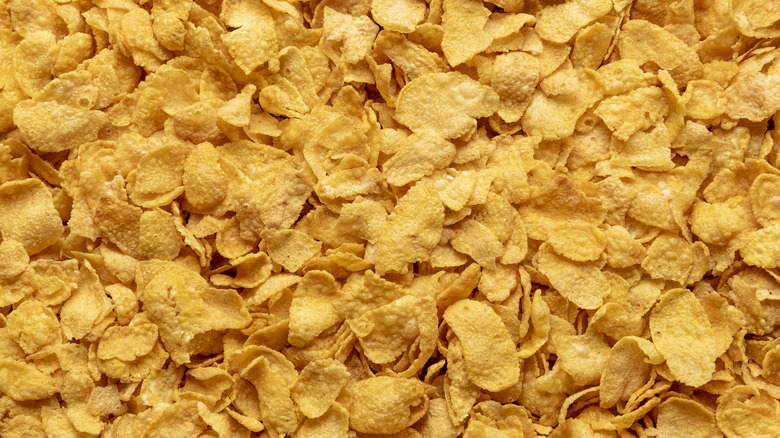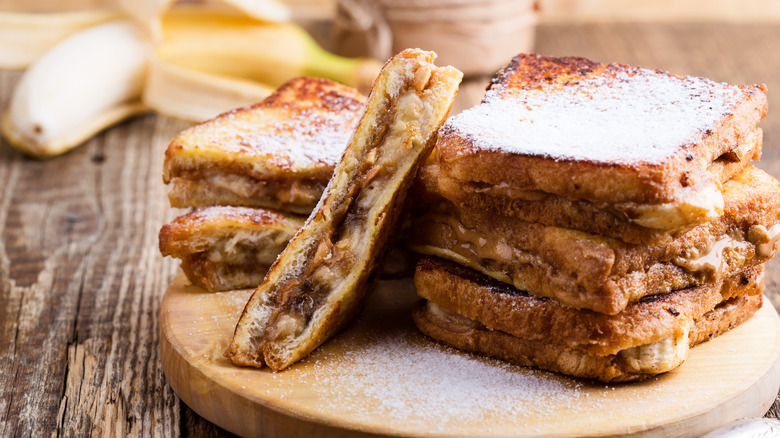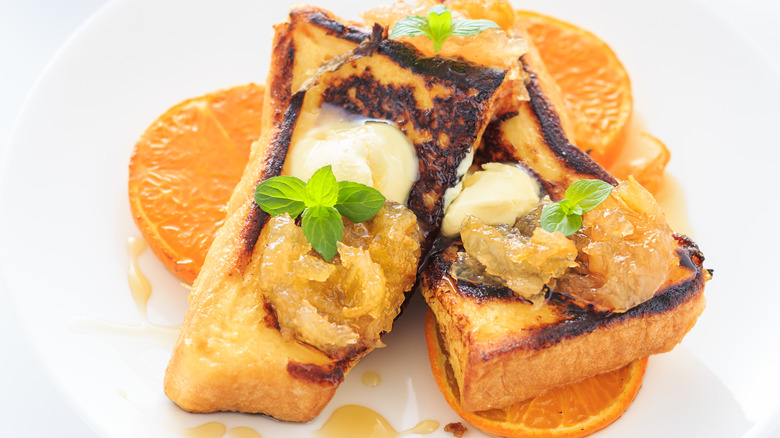Delicious Twists On French Toast That Will Stir Your Cravings
French toast is a staple on many a breakfast, brunch, or anytime table. As it turns out, when you soak stale bread in beaten eggs and milk and then pan-fry it, you get a divine ratio of crisp to moist that has surely been igniting cravings since the dish first became a thing back in 4th-century Rome or the Medieval era. It's hard to pin down an exact origin for French toast, just as it's not easy to land on a single name for it globally. It's eggy bread in the U.K., pain perdu (lost bread) in France, and has an array of other monikers worldwide. Whatever you call it, French toast is undeniably as versatile a food as the mighty egg.
A good, basic French toast recipe is an already delicious blank canvas just waiting for inspired cooks to put their creative touches on it, which they have done in spades. How many variations of French toast are out there? The number is unknowable, but these some upgrades that make our mouths water with anticipation.
Switch it to savory
French toast doesn't have to be a sweet affair. Tweak a few core ingredients and you've got a savory breakfast or dinner guaranteed to make an appearance on your table more than once. Why? Because you'll crave it (obviously), but also because there are just so many versions to play with. The approach is simple: Omit all sweet-leaning ingredients and swap them out for savory spreads, sauces, and seasonings.
For a simple savory take, just whisk Parmesan cheese into your eggs before dipping the bread in; this will be delicious enough. For a "cheesy garlic toast" effect, add a pinch of garlic salt to the mixture, leaving out any other salt you'd have thrown in. If you're feeling extra, slather your favorite spread on the toast when done, anything from pimento cheese to country ham spread. While you're at it, add a couple of over-easy eggs (over-hard if you don't want the yolk running all over everything, but why wouldn't you want that?) for a quasi-eggs-Benedict approach. Go full on eggs Frenchedict by pouring on this lemony hollandaise sauce.
Use Hawaiian rolls
The best bread for French toast depends on the texture you're going for. Thin-sliced sandwich bread gone a little stale is the classic, but brioche and challah make excellent French toast too, as does sourdough. That said, we've got another suggestion: Hawaiian rolls. Hear us out.
If you're not a fan of soggy bread, texture can be a concern with French toast. Some breads are more absorbent than others, and although you want it to soak up the egg mixture, you don't want it to soak up too much or you're in for a limp, soggy experience. Hawaiian rolls are similar to sourdough bread in that they're dense and slow-absorbing. (Unlike sourdough, however, they provide a hint of sweetness.) They're notably thick, too, so to make sure they absorb enough liquid, poke a few holes in the bottom of them with a toothpick before soaking them in your egg mixture, and don't leave them in it for more than 30 seconds. Cook them like you would any other French toast, browning on all sides.
Roll up your French toast
Whoever first thought to make a roll-up out of French toast did the culinary world a great service. Roll-ups are fun to eat whether you're opting for the fork and knife or taking the finger food route (highly recommended). There are recipes galore for French toast roll-ups, but they all involve pretty much the same basic steps that, once known, allow you to get creative with your ingredients.
To make roll-ups work, you'll need a pliable bread that's nonetheless sturdy and doesn't have a lot of holes for the fillings to squirt out of. Whatever fits this criteria can work, but regular white bread or buttermilk white bread are common choices. Cut the crusts off and flatten each slice with a rolling pin until it's about ⅛ an inch thick. For the filling, you've got a world of options that fall into two categories: spreads or solids. If you're working with a jam or spread, go ahead and slather it across the whole surface of the flattened bread. If you're going for thicker ingredients like cream cheese or sliced fruit, spread them only along the bottom edge of the slice. Finally, roll the bread up into a tight cylinder and treat the rest of the process like any other French toast recipe — including the part where you eat too much.
Stuff it with Nutella
Nutella — perhaps the world's most popular chocolate hazelnut spread — is a relative newcomer to the United States, having only first graced us with its presence in 1983, but it's gained a loyal following throughout the years. There's a fascinating history and culture around Nutella, but what we're most interested in is its chocolaty, nutty richness. It's commonly spread on crêpes and bread, so incorporating Nutella into a good French toast recipe is a natural next step.
You could easily treat it like a delicious afterthought, spreading it on your French toast slices when they come hot off the pan. However, we're advocating for getting the Nutella really involved. Nutella French toast is a dangerously simple recipe that consists of Nutella sandwiches dipped in the egg mixture and cooked up. Add a side or topping of sliced strawberries or bananas and you've got a colorful, flavorful dish you'll come back to time and again.
Get a little nutty
Besides providing extra crunch, nuts make a satisfying, delicious addition to nearly any twist on French toast. Another reason to give nuts a role in the French toast show is that they provide a range of nutritional benefits depending on which varieties you're using. Sure, your motivation for making French toast likely isn't related to its stellar health effects, but it's nice to know you're adding 7 grams of protein to your eggy bread with ¼ cup of almonds or omega-3 fatty acids with your walnuts (per Healthline).
Nutty French toast recipes are often oven-baked (we get into how to do baked French toast in the next section), but don't let that stop you from trying them on the stove. For pan-fried pecan-crusted French toast, chop your nuts very fine, and press your egg-coated bread into them (both sides, please) before moving the slices to the hot skillet for cooking. Other versions to experiment with include almond-crusted French toast (sliver the nuts in this case), pecan praline (sweet and gooey), pistachio (crush them), and walnut crumble (best as a baked French toast topping).
Bake it up in a sweet casserole
French toast is normally cooked on the stovetop, but letting your oven and baking pan do the work instead produces equally toothsome results. A major perk of baked French toast casseroles: They're the superior choice when feeding a group, as a single casserole yields anywhere from four to 12 servings. You can whip it up the morning of or prepare it the evening before, leaving it in the fridge overnight to soak in the liquid. Either method is a mostly hands-off approach that frees you up to fry some bacon or make mint and fruit salad as a side dish.
When making the switch from pan-fried French toast to an oven-baked casserole, make sure you're using robust bread. Plain white sandwich bread (or any bread that's too soft) can yield soggy results in the oven. A crusty French loaf that's a tad stale is a great option; sourdough, challah, or brioche are excellent too. Slice the bread into 1-inch-thick pieces — or tear it into bite-sized chunks if you're doing something like eggnog French toast casserole — and bake until the top is a rich golden brown and the custard is set.
Make it vegan
Great news: French toast isn't off the menu if you're cooking for a vegan eater. There's a myriad of delicious alternatives to the animal-sourced ingredients that the dish typically depends on for its texture and flavor. You may have to shop for a few items you haven't cooked with before, but the resulting delicious and inclusive meal is worth it. Plus, if you're trying to cut down on animal fats or aiming for a flexitarian lifestyle, you'll have the makings of a delicious breakfast recipe in your arsenal!
For the bread, choose any sturdy loaf free of milk, eggs, butter, buttermilk, casein, whey, gelatin, honey, or royal jelly. Instead of cow's milk, non-dairy options like unsweetened almond milk work great. The batter can include ground chia seeds or ground flax seeds, cornstarch for extra thickening and crispness, and even nutritional yeast for extra egg-like flavor. Using oil or vegan butter, cook for 2 to 3 minutes on each side until the crust is golden brown.
Try a cannoli-stuffed version
For an ultra-decadent take on French toast that will call to you more than once, consider a stuffed cannoli version. Cannoli are a traditional Sicilian dessert consisting of rolled up pastry shells stuffed with a sweet, creamy ricotta cheese mixture and deep-fried until brown and crisp. When making cannoli-stuffed French toast, the filling is the key takeaway from the original dessert. Your bread replaces the shells, and you'll use the same principle as with Nutella-stuffed French toast by making sandwiches out of the filling, soaking them in your egg mixture, and pan-frying or baking them.
To create your filling, you could adapt this Sicilian cannoli recipe to suit your desired servings of French toast. Alternatively, to keep things super-simple (and a tad lighter), mix together 1 cup of ricotta, ¼ cup of powdered sugar, and half a teaspoon of vanilla extract. Add in ⅓ cup of semi-sweet chocolate chips. Spoon out your cannoli filling onto two slices of bread, allowing ½ cup for each slice. Place the other slices, making the aforementioned "sandwiches," and pan-fry.
Turn it into stuffed French toast sticks
Like roll-ups, stuffed French toast sticks are the perfect finger food for a fun, low-key breakfast or as a dessert for guests to snag off a buffet table. Stuffed French toast sticks take the charms of regular French toast sticks and amplify them to the fullest effect. When dippable crispy bread meets sweet inner filling, it's a double win.
Making stuffed French toast sticks is easier than you might think. Remember the "sandwich" approach that you'd use to make regular stuffed French toast? In this case, you'll make multiple sandwiches (cut off and discard the brown crusts) with whatever sweet filling appeals to you, and cut each of them into three sticks. Dip each stick in melted butter and roll it in a mixture of sugar and cinnamon before baking. To help the French toast sticks keep their structure throughout the prep and cooking process, freeze them before and after slicing into thirds.
Add cereal for crunch
French toast already boasts a wild interplay of textures, from the crisp exterior to the custardy insides to whatever ooey-gooey fillings you opt for. Sometimes you want a little extra crunch, though. Nuts can provide that, but there's another pantry staple that adds an enjoyable crackling crispness to French toast; it also happens to be more budget-friendly than nuts. We're talking about breakfast cereal.
Crushed cornflakes are the most common cereal for this textural treat, but you're free to use any type you like, even Cinnamon Toast Crunch if you want to stay really on brand. Froot Loops could be a fun take (don't worry about having a weird mixture of fruit flavors; all Froot Loop colors taste the same). Rice Krispies work too, though their flavor won't be quite as pronounced in the finished product. The idea is simple: After soaking your bread in the egg mixture, press both sides of the slice into the crushed cereal and cook as usual.
Incorporate peanut butter into the mix
Peanut butter is a classic, versatile spread used not only in sweet treats alongside chocolate and jellies but also in savory recipes like West African peanut soup and Thai peanut sauce. A survey administered by the Statista Research Department found that nearly 300 million Americans ate peanut butter in 2020 — this spread is popular, to say the least. When it comes to pleasing the taste buds of whoever you're cooking for, putting peanut butter in or on your French toast is a pretty safe bet (unless you didn't inquire about nut allergies first — definitely do that).
The most basic way to incorporate peanut butter in French toast is to slather your slices with it when they're hot off the pan. The peanut-butter-stuffed approach is also worth trying. Treat it like any stuffed French toast recipe by forming peanut butter sandwiches to dip in the egg mixture before cooking. For a version fit for a king, add banana and crispy fried bacon, and savor the big hunk o' yum you've just made.
If you're in the finger-food mood, incorporate all of the above into French toast roll-ups. Flatten your slices, spread a dollop of PB along their bottom edges, add a layer of thinly sliced bananas and a strip of fried bacon, roll them up, and pan-fry them. Experiment with the dipping sauces: Maybe you'll fall in love with savory (barbecue sauce?), or perhaps you'll stick with sweet (maple syrup).
Make orange the star
Do a Google image search for the phrase "French toast fruit," and your computer screen will be saturated with red and blue. Strawberries and blueberries are the classic fruity accompaniment to French toast, and there's nothing wrong with that. They look pretty; they taste great. The only issue is that there's another fruit out there with the ability to wow when incorporated into French toast, and you might never think of it on your own. It took Martha Stewart's recipe for orange French toast to show us the light.
Martha doesn't have you covering your slices in orange marmalade or dousing them with hyper-sweet orange syrup. Instead, something much more subtle happens: a sophisticated, citrusy step up courtesy of orange zest, orange juice, and a smidge of orange liqueur. This trio goes right into the egg mixture itself. The result is a bright, perfectly integrated splash of orange flavor that sings its note loud and clear without silencing the rest of the ensemble. Top it with whatever appeals to you, whether that's caramelized orange slices, a dollop of marmalade, or just a pat of melting butter.
